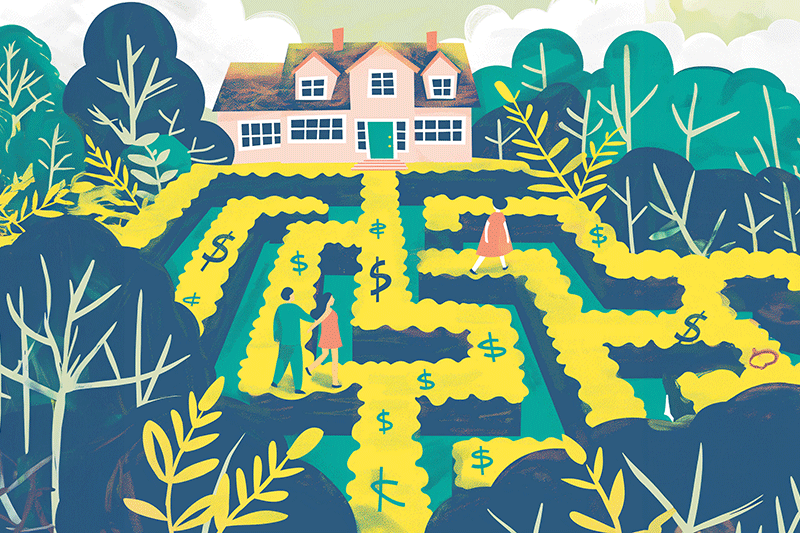Thompson Kane's team is dedicated to helping our community stay on top of the ever-changing…
Rising Home Insurance Costs: Why They’re High and What’s Being Done to Help
Home insurance costs have surged over the last few years, creating financial strain for homeowners nationwide. Driven by factors like natural disasters and rising rebuilding costs, this insurance “crisis” has forced some companies to raise premiums or even pull out of high-risk states. Despite these challenges, there’s reason for optimism: state and federal governments, alongside private insurers, are actively working on solutions to stabilize the market and make coverage more accessible. In this article, Thompson Kane explores the reasons behind rising home insurance costs and shares encouraging steps being taken to address this crisis.

Why Are Home Insurance Costs Rising So Rapidly?
The recent uptick in home insurance premiums can feel sudden and, for some homeowners, even surprising. However, a few significant contributors explain these sharp increases.
1. Increased Frequency and Severity of Natural Disasters
Natural disasters have become more frequent and severe, especially hurricanes, wildfires, and floods. Insurance companies now face record-high claims from these disasters, forcing them to charge more to cover escalating risks. Consequently, insurance costs have been particularly high in states like Florida, Louisiana, and California.
2. Climbing Construction and Rebuilding Costs
In addition to climate-driven risks, the cost of materials and labor for rebuilding homes has also soared—up nearly 19% since 2020. These increased costs directly affect premiums, as insurers need to account for the higher expenses they might incur in the event of a claim.
3. Rising Reinsurance Rates
Reinsurance, which is the coverage that insurance companies themselves purchase to offset their own risks, has also become more expensive. Reinsurance rates jumped by an estimated 50% in 2024 alone, another cost that gets passed along to policyholders.
The combination of these factors has resulted in an unprecedented market shift. In 2023, property and casualty insurers reported $21.2 billion in underwriting losses, leading some insurers to pull back on coverage, increase premiums, or exit certain states altogether.
Promising Developments to Ease Rising Home Insurance Costs
The impact of these challenges has not gone unnoticed, and stakeholders at every level are working on solutions to help stabilize the market. Here are some of the most promising initiatives now underway.
1. State-Level Innovation and FAIR Plans
At the state level, various programs are being implemented to help residents secure affordable home insurance. Many states have expanded their FAIR (Fair Access to Insurance Requirements) plans, which provide coverage options in high-risk areas where private insurance might be unavailable.
Additionally, states are testing creative approaches to support homeowners:
- Alabama’s Strengthen Alabama Homes program provides grants of up to $10,000 to help homeowners reinforce their properties against storms, thereby reducing future claims..
- Florida has enacted reforms aimed at reducing fraudulent litigation, which has already shown positive effects on stabilizing insurance rates.
- California is actively exploring regulatory reforms to ensure that insurers remain in the market while maintaining protections for policyholders.
2. Federal Grants and Risk Mitigation Programs
On a national level, the U.S. government has increased its investment in risk mitigation initiatives that lower long-term costs for both insurers and homeowners. Programs like the Hazard Mitigation Grant Program (HMGP) and the Building Resilient Infrastructure and Communities (BRIC) grant are helping communities strengthen infrastructure, adopt more robust building codes, and reduce the damage from natural disasters. These grants not only protect communities but also reduce the frequency and severity of insurance claims.
3. Technology and Data Advancements
Technology is playing a crucial role in managing insurance risks. New data models and predictive analytics help insurers assess risk more accurately, while advances in construction technology allow homes to be built to withstand severe weather. The growing adoption of FORTIFIED building standards, in particular, helps make homes more resilient and insurable, further assisting in lowering long-term costs.
4. Innovations in the Insurance Market
The insurance market itself is adapting with new types of policies, including surplus lines insurance, which provide coverage options outside of the traditional market. These policies can be especially helpful for high-risk properties. Additionally, financial instruments like Climate Risk Transfer Securities (CLRTs) offer new ways to distribute and manage risk, helping stabilize the market and create more affordable insurance options.
5. Proposed National Solutions
Looking toward long-term solutions, the Federal Natural Hazard Insurance Corporation (FNHIC) has been proposed as a way to provide comprehensive, affordable coverage for natural hazards nationwide. Modeled after the National Flood Insurance Program, the FNHIC could help stabilize the market and provide more accessible options for homeowners, especially those with low and moderate incomes.
How Thompson Kane Can Support Homeowners
The rising cost of home insurance is a complex issue, but efforts at every level are underway to help stabilize the market. At Thompson Kane, we understand that the rising costs associated with homeownership can feel overwhelming. If you have questions about the broader financial impacts of these trends on your home investment or want advice on other mortgage-related matters, our team is here to provide guidance.
Contact a Thompson Kane mortgage expert today to discuss your homeownership concerns and get the support you need to navigate these evolving challenges.




